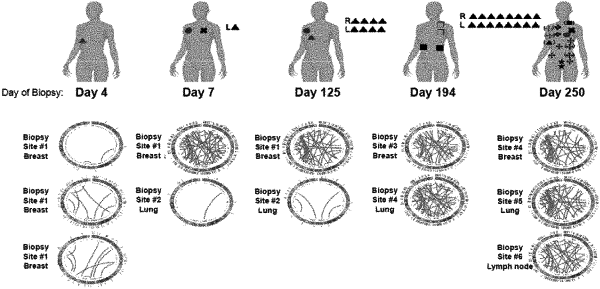| CPC A61K 39/0011 (2013.01) [G01N 33/57484 (2013.01); G16B 20/20 (2019.02); G16B 30/10 (2019.02); G16H 20/00 (2018.01); G16H 20/40 (2018.01); G16H 70/60 (2018.01); G01N 2800/52 (2013.01); G16B 20/00 (2019.02)] | 20 Claims |

|
1. A computer-assisted method of making an immunotherapeutic composition, the method comprising:
obtaining, from a patient, omics data from a tumor tissue, and comparing, via at least one processor, digital omics data stored in a computer-readable memory for tumor cells in a first location in a patient to omics data for tumor cells in a second location in the patient to identify respective DNA sequences that encode neoepitopes in the tumor cells of the first and second locations, wherein the omics data comprise whole genome DNA sequencing data or whole exome DNA sequencing data, and wherein the first and second locations are anatomically different locations, and wherein the neoepitopes are peptide sequences having a length of between 5 and 30 amino acids, and wherein the neoepitopes include a mutation in peptide sequences relative to an amino acid sequence from matched normal omics data from the patient;
determining, via the at least one processor, from a patient sample or the matched normal omics data, an HLA type of the patient;
calculating, via the at least one processor, for the neoepitopes respective binding affinities with respect to the determined HLA type of the patient;
selecting, via the at least one processor, high-affinity neoepitopes for the first and second locations that have a binding affinity to the determined HLA type of the patient of less than 500 nM;
selecting, from the high-affinity neoepitopes at least in part via the at least one processor, target neoepitopes for the first and second locations such that the target neoepitopes for the first and second locations have the same attribute, wherein the attribute is selected from the group consisting of a group attribute, a location attribute, a function attribute, a metabolic attribute, and a pathway attribute; and
generating an immunotherapeutic composition prepared for administration, the composition comprising a neoepitope-specific cell based composition, wherein the neoepitope-specific cell based composition comprises an immune competent cell that is genetically modified to express a chimeric antigen receptor that specifically recognizes or binds to the at least one of the target neoepitopes to target tumor cells in the first and second locations that express the target neoepitopes.
|